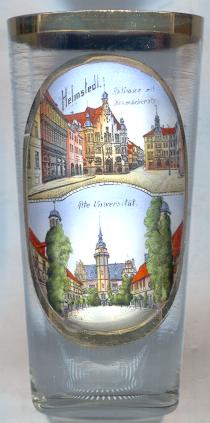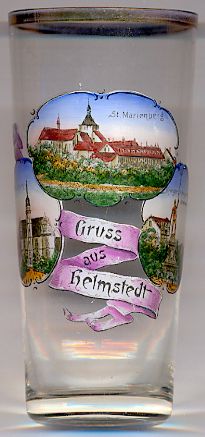

|
| DEUTSCHLAND | GERMANY |
| Bundesland: Niedersachsen | Lower Saxony |
| Landkreis: Helmstedt |
 Helmstedt was first mentioned in a document in AD 952 (Helmonstede).
During the war between the anti-emperors Otto IV of Braunschweig and Philipp of Swabia Hemlstedt was almost completely destroyed in 1199.
The status of a town was granted in 1247. Between 1247 and 1518 is was a member of the Hanse federation of German trading towns.
The old town is still characterized by more than 400 half-timbered houses dating from the 16th and 17th century.
Helmstedt was first mentioned in a document in AD 952 (Helmonstede).
During the war between the anti-emperors Otto IV of Braunschweig and Philipp of Swabia Hemlstedt was almost completely destroyed in 1199.
The status of a town was granted in 1247. Between 1247 and 1518 is was a member of the Hanse federation of German trading towns.
The old town is still characterized by more than 400 half-timbered houses dating from the 16th and 17th century.
The  University of Helmstedt ("Academia Julia") [bottom] was founded in 1576 by
Duke Julius of Braunschweig and Lüneburg, Prince of Braunschweig-Wolfenbüttel.
The Renaissance buildings date from 1575/76 (side wings) and 1592–1597 (central building, 'Juleum Novum').
At that time it was the most important protestant university in the Roman Empire of German Nation. At times, up to 15,000 students studied here.
Among the many important teachers of the university was also the famous Giordano Bruno. The world's probably first newpaper was published here in 1609.
During the times of French government, King Jérôme Bonaparte of Westphalia closed the university in 1810 to favour the university of Göttingen.
University of Helmstedt ("Academia Julia") [bottom] was founded in 1576 by
Duke Julius of Braunschweig and Lüneburg, Prince of Braunschweig-Wolfenbüttel.
The Renaissance buildings date from 1575/76 (side wings) and 1592–1597 (central building, 'Juleum Novum').
At that time it was the most important protestant university in the Roman Empire of German Nation. At times, up to 15,000 students studied here.
Among the many important teachers of the university was also the famous Giordano Bruno. The world's probably first newpaper was published here in 1609.
During the times of French government, King Jérôme Bonaparte of Westphalia closed the university in 1810 to favour the university of Göttingen.
The  Rathaus (Town Hall) [top left] was built in Neo-Gothic style in the late 19th century.
Rathaus (Town Hall) [top left] was built in Neo-Gothic style in the late 19th century.

The  Marienberg convent [near left, no. 2364: top picture]
is located on a hill within the municipality of Helmstedt. It was founded in 1176 by Abbot Wolfram of Kirchberg as an Augustine Canons' nunnery.
The convent survived the destruction of Helmsted of 1199 and also was spared during the siege of Helmstedt of 1279 during the wars of succession of the Guelf dynasty.
In the 19th century, however, the convent finally had been reduced to ruins and was completely rebuilt on the original foundations. Only some parts of the Romanesque
painted glass windows of the 12th century have survived in the convent's church. The fragments were assembled together in a window on the eastern side of the northern transept.
A new convent was founded in 1862, but the last nun died in 1984. Since 1989 the Marienberg is home to a Protestant convent. The convent operates a well-known
manufactury of paraments.
Marienberg convent [near left, no. 2364: top picture]
is located on a hill within the municipality of Helmstedt. It was founded in 1176 by Abbot Wolfram of Kirchberg as an Augustine Canons' nunnery.
The convent survived the destruction of Helmsted of 1199 and also was spared during the siege of Helmstedt of 1279 during the wars of succession of the Guelf dynasty.
In the 19th century, however, the convent finally had been reduced to ruins and was completely rebuilt on the original foundations. Only some parts of the Romanesque
painted glass windows of the 12th century have survived in the convent's church. The fragments were assembled together in a window on the eastern side of the northern transept.
A new convent was founded in 1862, but the last nun died in 1984. Since 1989 the Marienberg is home to a Protestant convent. The convent operates a well-known
manufactury of paraments.
The  Juleum or Juleum Novum [bottom left]
was built in 1592–1612 as a library and lecture room building for the university. It is regarded as one of the most important
building of the period of the Weser Renaissance in northern Germany. The building is named for Duke Julius, the founder of the university.
After the closure of the university in 1810, the Juleum was used spradically by local schools. Throughout the 19th and early 20th century the building deteriorated
significantly so that a thorough renovation was carried out between 1966 and 1971. The basement now houses the Helmstedt district and university museum, the ground
floor was remodeled to hold a large aula for public events. The rooms of the old library still hold about 35,000 volumes of the original library. The remaining
volumes today are in the collection of the Duke August Library in Wolfenbüttel.
Juleum or Juleum Novum [bottom left]
was built in 1592–1612 as a library and lecture room building for the university. It is regarded as one of the most important
building of the period of the Weser Renaissance in northern Germany. The building is named for Duke Julius, the founder of the university.
After the closure of the university in 1810, the Juleum was used spradically by local schools. Throughout the 19th and early 20th century the building deteriorated
significantly so that a thorough renovation was carried out between 1966 and 1971. The basement now houses the Helmstedt district and university museum, the ground
floor was remodeled to hold a large aula for public events. The rooms of the old library still hold about 35,000 volumes of the original library. The remaining
volumes today are in the collection of the Duke August Library in Wolfenbüttel.
The bottom right picture on glass no. 2364 shows the
 soldiers'
soldiers'
![[scale]](lineal.jpg)